It’s amazing
what you can see in just five days at Cristalino Jungle Lodge. On this private
tour I’m currently leading for a Finnish couple (with their two kids and a
nanny in tow), we saw and heard almost exactly 300 species of birds in just four full days at Cristalino, including
some really good ones. Three of them I’d seen only once before (and two were
lifers just last year in other parts of Brazil), one was a bird I had only
heard before, and two were new for the private reserve’s already huge list,
nearly 30 years old.
The title of
this blog is stolen from a Robert Cushman Murphy quote after he had seen an
albatross. But we now belong to a truly select group of very fortunate humans
who have laid eyes on a Scaled Ground-Cuckoo – the bird I had heard once before
while leading a tour here. Quick history on this species here, with nearly
unicorn status anywhere: One was glimpsed here in the late 1980’s, and then not
again until the early 2000’s. A couple more sightings followed, but it still
wasn’t settled as recently as five years ago what species they referred to, so
brief were these sightings (Rufous-vented Ground-Cuckoo is similar and also
very little known). Then began Jorge Lopez’ quest to document the bird. For the
past four years he and Francisco de Carvalho Souza, both fabulous local guides
and boatmen who have been working for Cristalino since about the beginning of
the enterprise, have been quietly and very gradually habituating these extraordinarily
shy birds to a bird bath and feeding station (with earthworms). About three
years ago Jorge let me and others in on his secret with the first photos. Then last
year he had video to show. But he didn’t think the birds were ready to show
tourists until this year, and even now it turns out to be a very iffy prospect.
Apparently one bird or a pair will come in two or three days in a row, then
vanish for 3 weeks or a month, confirmed with motion-sensitive camera traps. On
one of our afternoons this past week, Jorge told me that his previous day’s
worms had vanished, and that the cuckoos must be coming; he suggested we change
the afternoon plan to boat upriver and sit still for an hour watching his
feeder from a screened bench in the forest. OK, change made! We waited only 1/2
hour before we heard the bill snapping between two birds, and one came in three
times to eat the worms he hung from little nooses over the bird bath. While we
waited a Barred Forest-Falcon came in for a drink as well. As far as I know we
were the first lodge guests to have this privilege. Jorge has taken a few of
the local guides and special friends there, and until now perhaps only six
people had seen them. One of the local guides has been there 10 times without
seeing it. The next day, Jorge dared take a larger group of 9 well-behaved birders
from a Rockjumper tour, hoping the birds would come a third day in a row. They
didn’t, highlighting again for us how lucky we were. I had my spotting scope
set up on the spot and digiscoped these grainy shots in the dark forest
understory.
Another one
of the surprise birds was a Black Manakin, a first record for the Cristalino
area. We saw it briefly a couple times, Jarmo Komi snapped some photos, and I
sort of forgot about it, as we proceeded to see another 75 species that day. At
lunch we showed the photos to some others, eliciting mostly shrugging of
shoulders. But at our evening checklist session, we came to the manakins, and
that’s when it hit me what it was. Birds are known from very isolated locations
about 50 km north and about 100 km south, but in both places on a very short,
scrubby and viny forest on white sandy soils. This was an immature male,
probably a bit lost after dispersing from one of those areas, having found a
bit of similar looking habitat on the Manakin Trail. This is my photo of Jarmo’s
camera screen.
Then another
amazing find, right after the manakin, was this Rufous-tailed Attila, a little
known bird in the Amazon Basin where it apparently winters very sparsely. In
the austral spring it heads back to the more temperate SE Brazilian rainforest to
breed. Stupidly, this is my third one here of about 6 local records now, to the
consternation of all the local guides, some of whom have Cristalino lists larger
than mine.
On our hike
up the Serra, we tooted in this Amazonian Pygmy-Owl which was precisely the
lure we needed to bring in the continuing female Fiery-tailed Awlbill, which we
saw briefly, but didn’t get photos of. I had seen one 9 years ago, the photo of
which was the first documented record for Cristalino and the state of Mato Grosso.
The final
“rarity” I found was a Striped Cuckoo on the lodge grounds. This is a common
bird with a large range, but it is a recent invader to the shrubby pastures
that were all pristine rainforest just 30-40 years ago. Well within the
forested Cristalino reserve it was a big surprise. I first saw it feeding on
moths and spiders on the side of the guides’ dorm, and then it flew up to the
roof of the old kitchen where it sat for a couple minutes as it raised and
lowered its crest while thumbing its black alula. The photo isn’t worth
sharing.
One of the
hallmark birds for Cristalino is the Cryptic Forest-Falcon. They’re not rare
here, but they can be very quiet and sometimes shy, unlike this bird that
perched over our heads. It was here at Cristalino some 20 years ago that Andy
Whittaker first recognized this as being different from the more widespread
Lined Forest-Falcon, and he described it as a new species in a paper published
less than 14 years ago.
Cristalino
is so much more than just birds. This family of Giant Otters was in the river
as we were arriving, and we drifted downstream with them until they clambered on
this rock. What a greeting committee!
Inger
spotted this very quiet Southern Tamandua in a vine tangle over one of the
trails one afternoon. I’ve seen only 3 or 4 here over the years.
I went to
the rocks on my own one evening to look at fish. I had never seen this
long-nosed thing before, and there were several there. It appears to be a pike
characin of some sort, according to Gavin Bieber.
Gavin
suggests this is an Ancistrus sp., bushy-nosed
catfish, and that’s about the closest you can get to an actual name for
virtually any fish here, so little known is the piscifauna.
This butterfly
look-alike is actually a cane-borer moth in the family Castniidae. Best match
with online photos is Castnia icarus,
the prettiest I have seen.
While on the
Serra we saw the usual Cyrtopodium sp. orchids,
even some in bloom, but new to me was this Encyclia
cachimboensis, a plant which I’ve obviously walked past several times, but
never in bloom. It has a wonderful floral perfume, slightly spicy.
Butterflies
on the beach were underwhelming, despite my efforts. It’s perhaps too early in
the season; numbers seem to peak just before the rains in early September. Neographium thyastes, Orange
Kite-Swallowtail is always a nice find though.
I’m slowly
trying to learn spider families, most of which can be identified simply on the
basis of the eye placement. Most spiders have eight eyes, and a while back I
had already identified the common large, flat spiders on the rocks by the river
as members of the mostly neotropical family Trechaleidae.
This much smaller one
looked very similar, but it was on a tree trunk well inside the igapó forest on the Manakin trail. A close-up of the eyes shows that it has the same arrangement so I assume it’s in
that family.
A final
photo of dawn at Tower 1, a memorable vista with an unforgettable soundscape.




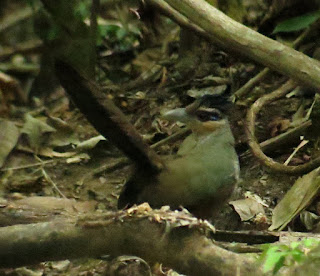


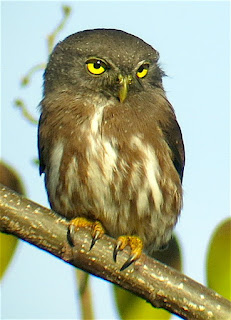

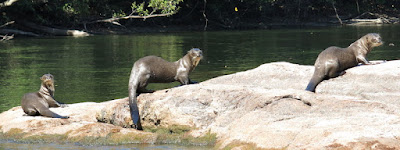
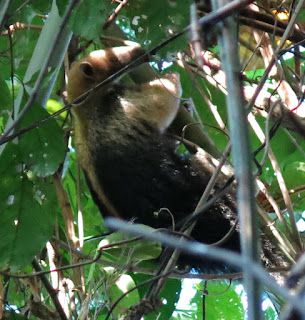



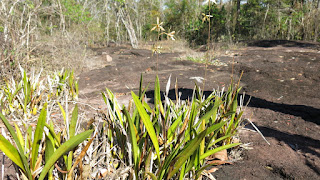
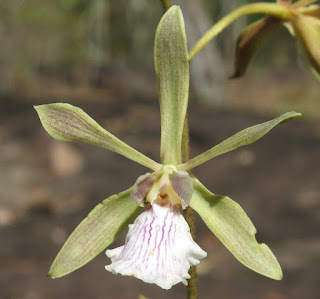



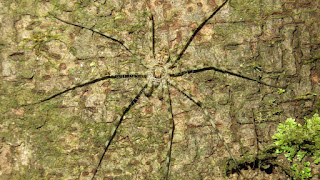
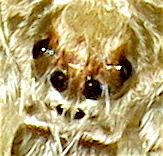






No comments:
Post a Comment